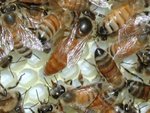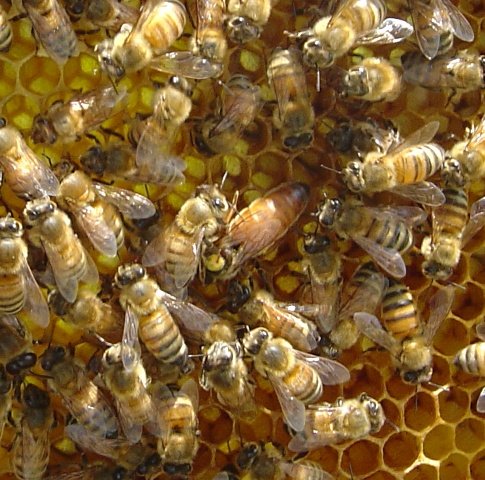.
 .
..
Left: The dreaded Varroa mite. The mite population increases through the summer months and can reach damaging numbers.
.
.
.
.
.
.
.
.
We are averaging about 10 lbs of honey per producing hive, and only 3 out of 7 hives are producing any honey. Last years yield was 60 lbs of honey per hive. This honey season has been a disappointing one. As a beekeeper, at this point, I can not see what could have been done better to produce more honey. The biggest factor was the spring weather. It was cold too long for the bees to build up in numbers and to take advantage of the spring honey flow. Then when the spring honey flow finally started, three weeks late, it was over too fast.
.
.
 Right: A screened bottom board with a sticky board installed. The screened bottom board allows Varroa mites to fall out of a colony and not climb back in. The sticky board is installed to collect the fallen mites in order to observe their numbers.
Right: A screened bottom board with a sticky board installed. The screened bottom board allows Varroa mites to fall out of a colony and not climb back in. The sticky board is installed to collect the fallen mites in order to observe their numbers..
August is when the Varroa mites show up in their greatest numbers. Detected in Kentucky in 1991 they have quickly spread throughout the country. A few years ago the cape lost about 80% of its bee colonies because of the Varroa Mites. The mites attach themselves to the bees, feeding off of them, weakening them, and spreading disease.
.

Right: A sticky board being removed from the screened bottom board after a 24 hour period. The mite levels found on the board will reveal if there is a mite population problem inside the hive.
.
A week ago I conducted a 24 hour mite drop count on all the colonies. Since I maintain a screened bottom board on most of the colonies, a slide in sticky board was used to collect falling mites over a 24 hour period. The sticky board is then removed and the mites counted. If only a few are found then it is an indication that the mite population is low within the colony. My mite count was in the hundreds in two of the colonies, with high counts in a third, and low counts in the others. I have never experienced mites in these numbers before. The trend was that the over-wintered colonies had a much higher mite count than the colonies started in 2007.
.
 .
..
.
Right: Enlarged area of the sticky board. Among the debris are great numbers of varroa mites. Not good news.
.
.
.
.
.
.
Before the hives can receive any type of medications or treatments the Honey must be removed from the hive. I installed escape boards which allow the bees to exit the honey supers, and not return. Within two to three days almost all the bees will have exited the honey supers into the brood chambers below where the queen is. After removing all of the honey, I was able to start formic acid treatments. Formic acid is found naturally in the colony. Adding formic acid pads inside the colony raises the formic acid level within the colony. This increased level does not hurt the bees, but kills both Varroa and Trachea mites. The treatment lasts 3 weeks after which the hives will be tested again for Varroa mites to insure their numbers are under control. Once the formic acid pads are removed, the acid levels return to normal.
.
.

Left: Closeup of the sticky board. Oil spray (like pam) is used on the board to keep the mites in place once they fall onto the board.
.
.
.
.
Since honey production was so low this year, the hives do not contain much honey for the bees to live on through the winter. We have started feeding the bees with a 1:1 ratio of sugar and water. The supplemental feeding has started early this year so the bees will have enough time to store it in the brood chamber.
.
 Left: The bottom of a bee escape board. The bees can come down through the round hole, and out the small openings, but are to dumb to find there way back. Once placed between the honey supers and the brood chamber this board will evacuate the bees from the honey super in three days.
Left: The bottom of a bee escape board. The bees can come down through the round hole, and out the small openings, but are to dumb to find there way back. Once placed between the honey supers and the brood chamber this board will evacuate the bees from the honey super in three days..
I am hoping that there will be an abundance of Goldenrod bloom this fall. The Goldenrod is the last major producer of nectar and pollen for the bees before the frost and cold weather set in.
.
 .
..
.
Right: Installed bee escape board.
.
.
.
.
.
.
.
.
We will be extracting what honey we can this weekend!
That’s always fun!
.
 .
..
.
Left: Bees feeding on pollen patty supplements. This stimulates brood production.
.
.
.







Here in the UK we've had a rotten summer, weather wise, and a rotten honey harvest (i.e. no honey harvest at all) for that reason. I had to feed one colony in July because they had zero stores. Hope you have a better crop than us.
ReplyDeleteI live in Atlanta, Georgia and am a hobby beekeeper with 3 hives. Mite count was monitored and all did well. I took an organic beekeeping class this year and was doing all of the organic stuff to help control mites, beetles, ect. Things seemed to be going OK. Then in Late August my mite count started to rise. I use the drop method of counting on the board. I reached the danger level in all three hives. Nothing organic I did could get the mite count down. I went to formic acid. Got things under control and now October 11, 2008 am having to retreat using formic acid again. One of my hives had 807 dead mited in a 24 hour period. I do know why now all of the articles say if you do not get your mites in check your colony will not survive the winter.
ReplyDeleteJohn Jones
Stone Mountain, Georgia.
Nice Blog.